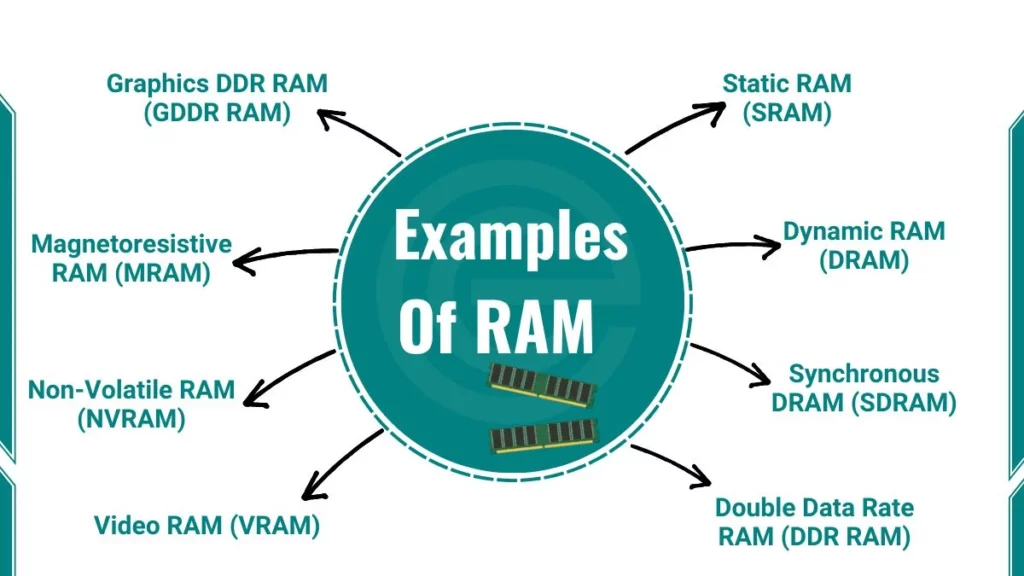Examples of RAM include SRAM, DRAM, SDRAM, DDR RAM, VRAM, NVRAM and many more. Below, we look at all these examples in detail.
RAM is essential to every computer and smart device. It helps your device run smoothly by storing data temporarily while you work.
Examples of RAM
Here are the different types of RAM:

1. Static RAM (SRAM)
SRAM stores data using six transistors per memory cell. It does not need constant refreshing. This makes it much faster than other types of RAM. SRAM is used in CPU cache memory to speed up data access. It is very reliable and consumes less power. However, it is expensive and has a lower storage capacity than DRAM.
For example, SRAM is like a quick-thinking assistant. It helps your computer solve problems faster, especially when playing games or editing videos.
2. Dynamic RAM (DRAM)
DRAM stores data in capacitors, which need frequent refreshing. It is slower than SRAM but can store more data. Most computer RAM modules use DRAM to handle running applications. It is cheaper to produce. It is a common choice for personal computers. However, due to constant refreshing, it consumes more power and is slightly slower.
For example, think of DRAM as the memory in your school laptop. It helps you switch between your browser, Word document, and PowerPoint without slowing down.
3. Synchronous DRAM (SDRAM)
SDRAM works in sync with the computer’s CPU clock. This improves data transfer speed compared to traditional DRAM. It allows multitasking by processing multiple instructions at the same time. Many older desktops and laptops use SDRAM for smooth performance. It helps manage background applications efficiently.
For example, SDRAM is like a well-coordinated team. Everyone works together in sync to get tasks done quickly.
4. Double Data Rate RAM (DDR RAM)
DDR SDRAM is an advanced version of SDRAM. It transfers data twice in every clock cycle and increases speed. It is used in modern computers, gaming PCs, and servers. Different versions of this RAM exist, such as DDR3, DDR4, and DDR5, DDR RAM helps in running multiple applications smoothly. It also improves performance for gaming and video editing.
For example, DDR SDRAM is like upgrading from a bicycle to a sports car. Your computer can handle more tasks at once without slowing down.
5. Video RAM (VRAM)
VRAM is a special type of RAM used for graphics processing. It stores image data and helps display visuals smoothly. High-end graphics cards in gaming PCs use VRAM to load images, videos, and 3D models quickly.
It improves the performance of games and design software. VRAM reduces lag in video rendering and animations. It is faster than standard RAM but is mainly used for visual processing.
For example, VRAM is like an artist’s canvas. It holds all the details of your favourite video game visuals.
6. Graphics DDR RAM (GDDR RAM)
GDDR RAM is an advanced type of VRAM. It provides high bandwidth for graphics-intensive tasks like gaming and 3D rendering. It is similar to DDR RAM but optimized for faster data transfer. GDDR5, GDDR6, and GDDR6X are the latest versions used in modern GPUs. It ensures smooth frame rates and reduces screen tearing in games.
7. Low Power DDR RAM (LPDDR RAM)
LPDDR RAM is designed for smartphones, tablets, and lightweight laptops. It consumes less power than regular DDR RAM, extending battery life. Devices like mobile phones and ultra-thin laptops use LPDDR4 and LPDDR5 for efficient multitasking. It provides smooth performance while saving energy. It is slower than desktop DDR RAM but ideal for portable devices.
For example, LPDDR RAM is like the energy-saving mode on your phone. It keeps your device running all day without draining the battery.
8. Non-Volatile RAM (NVRAM)
NVRAM stores data even when the power is turned off. It is commonly used in routers, printers, and embedded systems. It helps store system settings that need to be saved permanently. Unlike DRAM, it does not need refreshing. This makes it useful for configurations that should not be lost. NVRAM is reliable but has limited storage capacity.
9. Error-Correcting Code RAM (ECC RAM)
ECC RAM detects and corrects memory errors automatically. It is used in servers, workstations, and financial systems where data accuracy is critical. It prevents crashes caused by corrupted memory. Businesses and industries rely on ECC RAM for high-reliability computing. It is slower and more expensive than regular RAM but ensures system stability.
10. Magnetoresistive RAM (MRAM)
MRAM is a modern type of RAM that uses magnetic storage instead of electrical charges. It retains data even when the power is off. Some industrial and automotive devices use MRAM for fast and permanent storage.
It combines the speed of SRAM with the non-volatility of NVRAM. MRAM is durable and energy-efficient. It is still developing and may replace traditional RAM in the future.
